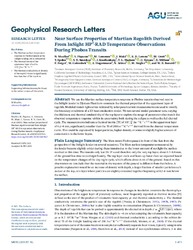Near Surface Properties of Martian Regolith Derived From InSight HP3‐RAD Temperature Observations During Phobos Transits
Knollenberg, J.
Krause, C.
Forget, F.
Hagermann, A.
DOI: https://doi.org/10.1029/2021GL093542
Persistent URL: http://resolver.sub.uni-goettingen.de/purl?gldocs-11858/9526
Persistent URL: http://resolver.sub.uni-goettingen.de/purl?gldocs-11858/9526
Mueller, N.; Piqueux, S.; Lemmon, M.; Maki, J.; Lorenz, R. D.; Grott, M.; Spohn, T.; Smrekar, S. E.; Knollenberg, J.; Hudson, T. L.; Krause, C.; Millour, E.; Forget, F.; Golombek, M.; Hagermann, A.; Attree, N.; Siegler, M.; Banerdt, W. B., 2021: Near Surface Properties of Martian Regolith Derived From InSight HP3‐RAD Temperature Observations During Phobos Transits. In: Geophysical Research Letters, Band 48, 15, DOI: 10.1029/2021GL093542.
 |
Dokument öffnen: |
We use the Martian surface temperature response to Phobos transits observed next to the InSight lander in Elysium Planitia to constrain the thermal properties of the uppermost layer of regolith. Modeled transit lightcurves validated by solar panel current measurements are used to modify the boundary conditions of a 1D heat conduction model. We test several model parameter sets, varying the thickness and thermal conductivity of the top layer to explore the range of parameters that match the observed temperature response within its uncertainty both during the eclipse as well as the full diurnal cycle. The measurements indicate a thermal inertia (TI) of 103−16+22Jm−2K−1s−1/2 in the uppermost layer of 0.2–4 mm, significantly smaller than the TI of 200Jm−2K−1s−1/2 derived from the diurnal temperature curve. This could be explained by larger particles, higher density, or some or slightly higher amount of cementation in the lower layers. Plain Language Summary:
The Mars moon Phobos passed in front of the Sun from the perspective of the InSight lander on several occasions. The Mars surface temperatures measured by the lander became slightly colder during these transits due to the lower amount of sunlight the surface received at this time. The transits only last 20–35 s and therefore only the very top layer, about 0.3–0.8 mm, of the ground has time to cool significantly. The top layer cools and heats up faster than we expected based on the temperature changes of the day‐night cycle, which affects about 4 cm of the ground. Based on this observation we conclude that the material in the top mm of the ground is different from that below. A possible explanation would be an increase of density with depth, a larger fraction of smaller particles such as dust at the top, or a layer where particles are slightly cemented together beginning at 0.2–4 mm below the surface. Key Points:
The Martian surface temperature response to Phobos transits at the InSight landing site is interpreted.
The thermal inertia of the uppermost layer of soil is 103−16+22Jm−2K−1s−1/2.
The thermal conductivity or density of the top 0.2–4 mm is significantly less than that of the top 4 cm.
Statistik:
ZugriffsstatistikSammlung:
This is an open access article under the terms of the Creative Commons Attribution‐NonCommercial‐NoDerivs License, which permits use and distribution in any medium, provided the original work is properly cited, the use is non‐commercial and no modifications or adaptations are made.

